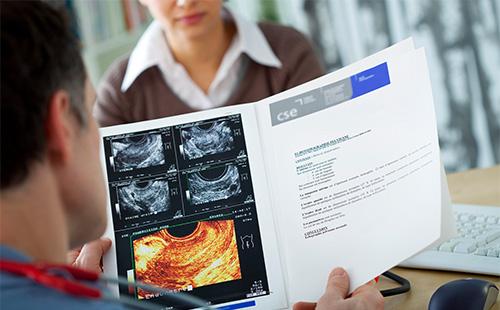The content of the article
“Chocolate” endometriosis is called because in the foci a similar color and consistency is formed, the contents are like liquid dark chocolate. These are coagulated blood and cellular elements. The insidiousness of endometriosis lies in its constant relapse, complex and lengthy treatment, and a high likelihood of the formation of an adhesive process in the small pelvis. According to the international classification of diseases (ICD-10), endometrioid cysts pass under the code N 80.1.
Often women, having received such a diagnosis, start to panic: what does an endometrioid cyst mean - which, out of ignorance, is often called an endometriotic or endometrial cyst - does it hurt, what code does ICJ-10 have ...
What it is
Normally, endometrial cells should be present only in the uterine cavity. They undergo monthly transformations - they grow in the first phase of the cycle, then they are rejected and come out with menstrual blood. They do not accumulate in the cavity, but regularly go outside.
In pathology, cells that are histologically similar to endometrium somehow penetrate to other places where they should not be normal. Most often they are found:
- in the muscle layer of the uterus, on its neck;
- on the fallopian tubes;
- in the ovaries;
- on the peritoneum (it covers all internal organs);
- on intestinal loops.
Here they undergo the same transformations as in the uterine cavity. But the problem is that often there is no communication with the environment and the whole secret accumulates over the years with rejected cells. As a result, a cyst of five and even more centimeters is formed from the focus in the ovary of several millimeters. And the monthly secretion of menstrual-like fluid leads to a constant increase in formations and a bright clinic - pain, daub.
Endometrioid cysts are the lot of young women, since endometriosis itself is a hormone-dependent disease. In menopause, any foci undergo regression and pass independently, since for them there is no “nourishment” (sufficient estrogen-progestogen background). They proceed from these principles in the treatment of the disease - with the help of hormones they temporarily suppress ovarian function, which helps to achieve a long-term remission of the pathology and the disappearance of symptoms.
Symptoms of an endometrioid ovarian cyst
Endometriotic cysts can be a “find” during a gynecological examination or a planned ultrasound, but with a detailed questioning of a woman, symptoms that are not given importance are still revealed. Most often, endometriotic cysts are combined with other forms of endometriosis, so the clinical picture is bright.
Symptoms of endometrioid ovarian cysts always become more noticeable on the eve of menstruation, and after them are not very pronounced. The main ones include the following:
- pain in the lower abdomen;
- discomfort during sexual intercourse;
- violation of the cycle (delay or intermenstrual daub);
- a feeling of pressure on the rectum;
- problems with conception;
- diarrhea and pain during bowel movements on the eve of menstruation.
Almost always in parallel, signs of endometriosis of the uterus or cervix are detected:
- spotting brown discharge on the eve and after menstruation;
- heavy and painful menstruation.
Who develops more often
Today, endometriosis is one of the common gynecological pathologies. To one degree or another, it is found in every fourth to fifth woman. This is due to both an increased level of diagnosis and an increase in the frequency of surgical interventions on the genitals in women of the reproductive period. The following women are at risk for the development of endometriosis.
- With burdened heredity. In 80% of cases of endometriosis, the disease line is traced in close relatives: sisters, mothers, and grandmothers. This suggests that women suffering from endometriosis have some peculiarities of the immune system and the whole organism, as a result of which the migrating endometrial cells "take root" in the wrong places.
- After cesarean section. During suturing the uterus and removing the fetus, endometrial cells can freely enter other organs, which often happens, especially if the rules for protecting tissues are not followed. Endometrioid cysts and foci in other places occur a few years after the intervention.
- After other operations. All actions during which the surgeon contacts the inner layer of the uterus (for example, when removing nodes) also increase the risk of endometriosis.
- With immunodeficiency. It is believed that menstrual reflux and endometrial cell migration occurs in all women, however, clinical manifestations of endometriosis are not always present. It all depends on the reactivity of the immune cells - in case of failure in their work, the body allows the endometrium to take root in pathological places. This is proved by immunological shifts in analyzes in women with endometriosis.
Stages
Endometriosis is classified as follows.
- First degree. Identified single small foci on the peritoneum.
- Second degree. Appears endometriosis of the appendages with numerous adhesions around the appendages.
- Third degree. Progression of endometrioid foci to organs adjacent to the uterus - the bladder, rectum, ureters, appendix.
- Fourth degree. Dissemination of endometriosis in the peritoneum and beyond the pelvic area.
What can lead to
Ovarian endometriosis is accompanied by serious changes in the body of a woman. The severity of the disease is determined not so much by the size of the cyst, but by the presence of foci on adjacent organs and the peritoneum. The more active the process, the more pronounced the adhesion process. This leads to obstruction of the fallopian tubes and infertility. In addition, endometriosis of the appendages can provoke the following conditions.
- Hormonal disorders. There is anovulation and menstruation in the type of algomenorrhea (soreness) and lengthening of the cycle.
- "Absorption of sperm." Endometriosis independently increases the activity of inflammatory reactions in the small pelvis, this leads to the fact that male germ cells are absorbed along with others and infertility occurs.
- Inferiority of the second phase. Hormonal and inflammatory changes lead to various transformations of the endometrium, for example, to the formation of polyps and hyperplasia. In addition to the fact that this causes problems for a woman (heavy periods, pains), inferiority of the second phase leads to infertility.
What is complicated
Endometrioid ovarian cysts can have the same complications as ordinary similar formations.
- The gap. Occurs with a sharp increase in intra-abdominal pressure, usually against the background of physical stress or sudden movements. In addition to the contents of the cyst entering the abdominal cavity, internal bleeding begins, which threatens the woman's life. In such cases, urgent surgical intervention is necessary.
- Inflammation. When an infection (for example, sexual or nonspecific) is attached, the cyst becomes inflamed and becomes more susceptible to trauma. This increases the likelihood of it breaking. In addition, with the activation of inflammation, an abscess may form.
- Torsion. In case of malnutrition of the cyst (torsion of its legs, where the feeding vessels go), necrosis of its tissues occurs, which is fraught with the development of peritonitis.
Can there be cancer?
Endometriosis, some researchers attribute to background diseases for the development of cancer. Statistics are provided that in 10% of cases of the disease, genital cancer develops, and the proportion of malignant ovarian tumors in this structure is greatest.
This is due to the fact that endometrioid cysts stimulate constant reparative processes in the ovaries, thereby increasing the frequency of spontaneous mutations and the likelihood of cancerous degeneration.
Diagnostics
The following steps are required to detect an endometrioid ovarian cyst.
- Gynecological examination. In a routine study, an enlarged right or left ovary is determined. But if the endometrioid cyst is small, the appendages by touch can be within normal limits.
- Ultrasound procedure. When performing ultrasound, even small endometrioid cysts up to 1 cm are detected. Moreover, there are diagnostic criteria by which with high reliability it is possible to indicate precisely the endometriosis of the appendages.
- Laparoscopy. For the purpose of diagnosis and treatment, laparoscopy can be performed. It allows you to see the structure of the genital organs and assess the prevalence of endometriosis.
Additionally, on the eve of surgical treatment of endometrioid cysts, the following studies are performed.
- Blood on tumor markers. With endometriosis, they can be higher than normal, most often CA-125 increases (no more than 100 with a norm of up to 35 U / L). Assays for ROMA and CEA may be normal.
- Examination of the intestines and stomach. Ovarian cancer with progression gives metastases to these organs. Kruckenberg metastasis (with stomach cancer) is detected as a cyst in the left ovary. Therefore, to exclude the oncological process in the body, a study of these organs is necessary. Radiography of the lungs is also performed.
- Culdocentesis. This is a puncture of the abdominal cavity through the posterior vaginal fornix.Cells obtained in flush or aspirate are examined.
Is it possible to get rid forever
If a woman claims that her endometrioid ovarian cyst has resolved, there was most likely an error in diagnosis and this was not endometriosis. Small-sized tumors can pass on their own only during menopause (since there is no hormonal support), as well as during lactation and during pregnancy, when gestagen promotes this. In young women of reproductive age without surgery or at least drug treatment, endometriosis only progresses.
Drug therapy
The basis of drug treatment is hormonal drugs that create a condition similar to that in a woman’s body menopause (sometimes called artificial menopause). These may be the following groups.
- Birth control pills. Against the background of their intake, the intrinsic function of the ovaries decreases, which leads to regression of foci. Endometriosis of a few millimeters goes away, but it is not worth hoping that the cysts pass in a couple of centimeters, they will only slow down their growth. Appointed, for example, "Regulon", "Novinet", "Jess", "Yarina". The disadvantage of this treatment is the preparations in tablet form and they need to be taken daily.
- Analogs of gestagens. They create a special hormonal background that inhibits the growth of endometrial cells. Used "Utrozhestan", "Dufaston", "Byzanne." These drugs also have to be taken continuously.
- Antigonadotropic drugs. They reduce the production of FSH, LH, estrogen and progestogen, which leads to a decrease in ovarian function. The representative of the group is Danazol.
- Analogs of gonadotroping hormones. This group includes Zoladex, Buserelin. They reduce the production of FSH and LH due to the artificially created concentration of these hormones. The drugs are convenient to use - there are injectable or intranasal forms (for injection into the nose). Moreover, the medicine must be administered once every one or three months according to the scheme.
In addition, symptomatic therapy is used:
- anti-inflammatory drugs — «Indomethacin"In the form of candles or tablets," Diclofenac "," Ibuprofen ";
- reducing adhesion formation - “Lidaza”, “Wobenzym”;
- vitamin preparations - most often groups B, A, E and C.

Surgery
Removal of the endometrioid ovarian cyst is carried out according to the following indications:
- if it reaches 3 cm or more in diameter;
- if there is infertility;
- with common endometriosis.
Laparoscopy is considered the "gold standard" in treatment. Its main advantages in the treatment of this pathology are as follows:
- it is a minimally invasive operation;
- low blood loss;
- fast recovery in the postoperative period;
- an increase is used, so even the microcenters of endometriosis are visualized.
But after surgical removal of the cyst, there is no 100% chance that endometriosis will not recur. Reviews of many girls confirm the fact that it is necessary to perform not one, but several operations, and all the same, foci appear. Therefore, treatment should be comprehensive and lengthy - for many years. The following options are possible:
- The first scheme. Removal of large foci with subsequent administration of antigonadotropic drugs or gonadotropin agonists for three to six months. After that, a long-term administration of oral contraceptives is necessary - five or more years.
- The second scheme. Surgical removal of foci with subsequent administration of hormonal preparations. Further their cancellation and pregnancy planning.After birth, you should breast-feed the baby for as long as possible (preferably up to three years). With lactation, the created gestagen background also contributes to the regression of foci.
Complications after laparoscopy
During laparoscopy of an endometrioid ovarian cyst, a doctor has to cauterize areas of the altered tissue. Therefore, the larger the size of the formation, the less functional healthy elements remain. If there are cysts on two ovaries, even after one laparoscopic operation, ovarian failure and early menopause may subsequently occur. With each subsequent operation, ovarian function decreases. Therefore, it is in the woman’s interests to carry out as few interventions as possible, and to complement the treatment with drug therapy.

When to plan a pregnancy
Many women experience endometriosis when planning pregnancy is unsuccessful. Indeed, an ailment can provoke infertility. If so, endometriosis should be treated comprehensively at the planning stage. If endometrioid cysts are detected for the first time and a woman wants a pregnancy, it is also recommended to remove them before conception.
In the case when this is a relapse, one should carefully consider the selection of treatment so as not to subsequently go to the syndrome of exhausted ovaries and early menopause, which can occur even earlier than 35 years.
How to prevent ailment
Prevention of endometriosis consists in strengthening immunity and minimizing the number of interventions on the genitals (for example, curettage, cesarean section). It is useful for girls with a predisposition to endometriosis or with minimal manifestations of it to use hormonal drugs as protection as long as possible.
The causes of endometrioid ovarian cysts are still ambiguous. Ignorance of the basics of the disease leads to frequent relapses of the disease, even after a complex laparoscopic and drug treatment. Such formations are at risk of malignancy, rupture or inflammation of endometrioid ovarian cysts may occur. Therefore, they require not only observation, but also active, competent and long-term treatment.

